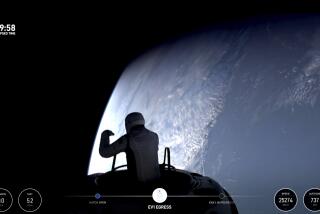Problem With Cosmonaut’s Suit Halts Spacewalk
- Share via
KOROLYOV, Russia — An astronaut and cosmonaut at the orbiting international space station cut short a spacewalk early today when the cosmonaut’s spacesuit malfunctioned, overheating and causing condensation that blurred his vision.
The nearly four-hour spacewalk was the first conducted from the station without a crew member remaining inside to monitor equipment and help in case of an emergency. It had been expected to last about 5 1/2 hours.
American Michael Foale and Russian Alexander Kaleri floated out from the station shortly after midnight Moscow time. Some time after 3 a.m., sensors indicated that the temperature inside Kaleri’s spacesuit had begun to rise, and condensation inside the suit became more intense, Russian mission control spokesman Vsevolod Latyshev said. The reason for this was not clear, and the crew continued to work, he said.
But Kaleri was advised to shake his head less, to work less intensively and try to avoid direct exposure to the sun as much as possible, he said.
The spacewalkers had been expected to wear new Russian-made Orlan-M spacesuits. But it was decided at the last moment that Foale and Kaleri would make the spacewalk in old suits, also Russian-made, rather than the new ones.
“It is because the old spacesuits had some resources left, enough for one spacewalk,” explained Vladimir Solovyov, head of mission control for Russian aspects of the space station. “We are saving our space equipment now because it’s expensive. It was decided to make full use of the old spacesuits.”
During a communication session, Kaleri said the water drops that formed on the inside of his helmet seriously blurred his vision, said a Russian mission control employee who spoke on condition of anonymity. She added that Solovyov was lighthearted in telling Kaleri to take it easy, saying, “It’s time for Russians to stop work. Let Americans work hard.”
But the temperature continued to rise, and the condensation continued, Latyshev said. It was decided to cut the spacewalk short, he said, and part of the work was not completed.
They reentered the space station at 4:13 a.m. Moscow time, he said.
At 4:45 a.m., mission control officials could be heard speaking with the astronaut and cosmonaut in the docking compartment. “Despite all the problems, your medical readings are excellent, if that makes you happy,” an official told Kaleri.
Relief, both on the ground and in the station, was palpable. The crewmen were asked to inspect each other’s suits, and Foale found that a pipe carrying coolant in Kaleri’s suit was dented.
“It must have happened when you were putting the suit on,” mission control told Kaleri.
“I can’t imagine how it could have happened,” Kaleri replied.
“You could have done it during your work when you pressed against something with your chest,” mission control said.
“No, I couldn’t. It’s on my stomach,” Kaleri replied.
Someone laughed at mission control and said: “Maybe you flexed your stomach muscles too hard.”
Kaleri laughed.
The station was put in standby mode and controlled from Earth while Foale and Kaleri were outside. The walk was being monitored both from Russian Mission Control Center in Korolyov, just outside Moscow, and at NASA’s mission control in Houston.
Preparations had been made for the men to board a Russian Soyuz escape vehicle to return to Earth without reentering the station if something went wrong, space officials said. Last week they practiced getting into the capsule wearing the new suits.
The grounding of the U.S. space shuttle fleet after last year’s Columbia disaster has led to a reduced crew presence on the station, and some NASA officials have questioned the safety of conducting a spacewalk in such circumstances. But the Russians wanted to press ahead, and the U.S. agreed.
Preparation for exiting the station began Thursday evening, with the two closing off the hatches connecting other parts of the station to the American Destiny module and a Russian Progress cargo ship docked with the station, the Russian news agency Itar-Tass reported.
During their spacewalk, Foale and Kaleri were expected to conduct work related to a variety of scientific experiments, including some for European and Japanese space agencies.
The still-unfinished station is a $100-billion project of the U.S., Russia, Japan, Canada and Europe.
One set of experiments to measure radiation dosage involved a European mannequin nicknamed Mr. Rando and a Russian device nicknamed a matryoshka, or nesting doll, Itar-Tass reported. Researchers want to learn more about the radiation exposure that astronauts face during spacewalks and on long journeys. The two devices were successfully placed outside the station, officials said.
The astronaut and cosmonaut also were expected to check the exterior of the station for any damage that might have occurred when a metallic sound was heard in November. A tiny meteoroid was suspected. They took photos of the area from which the sound had been heard, officials said.
The men also planned to install “laser-basing equipment” to enable a new European Space Agency cargo ship to dock with the station next year, but didn’t have time for that, officials said. Foale and Kaleri also retrieved equipment for some Japanese and Russian experiments.
The spacewalkers were monitored by means of a video camera installed on the arm of a Canadian-made manipulator.
*
Times staff writer Sergei L. Loiko contributed to this report.
More to Read
Sign up for Essential California
The most important California stories and recommendations in your inbox every morning.
You may occasionally receive promotional content from the Los Angeles Times.













